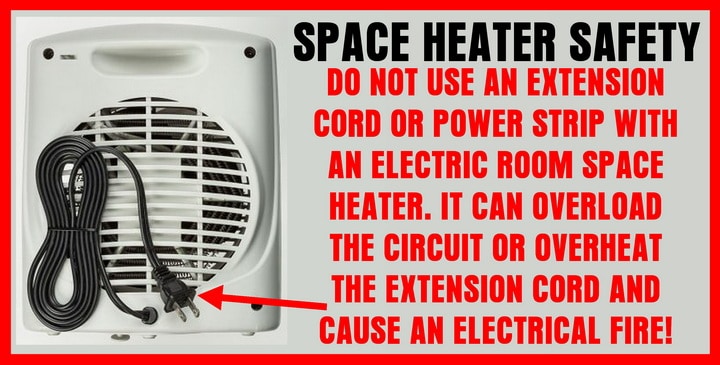Space Heaters Can Be Fire Hazards — Is Yours?

According to the National Fire Protection Association (NFPA), heating equipment is the leading cause of fires in the United States.
Don’t take it for granted that your “reliable” old space heater is perfectly safe and never a fire hazard. The price of presuming that all is safe could be your home, your life, your loved ones.
This winter is bringing about cold temperatures and snowy conditions across the country, with more chilly days ahead. If you don’t have a reliable radiator, heat source or you simply don’t want to have the heat going all day long — you may want something beyond bundling up in a winter coat or snuggling beneath a heated blanket.
One convenient and cost-effective way many homes can keep a specific area or room warm is by using a space heater. And while space heaters can keep you toasty, they are not without a set of risks.
Most notably, space heaters can be a fire hazard, as we have tragically seen in the recent high-rise apartment fire in the Bronx. According to the National Fire Protection Association (NFPA), heating equipment is the leading cause of fires in the United States. They are associated with more than 25,000 residential fires and 300 deaths annually, according to the Consumer Product Safety Commission.
When using a space heater, it’s crucial to follow manufacturer instructions as well as expert guidance provided by resources like the United States Department of Energy. Here are a few space heater safety tips to keep in mind when using a space heater.
1. Never, ever plug a space heater into a power strip — NOTE: This is a HUGE fire hazard

When it comes to powering your space heater, the U.S. Department of Energy recommends always plugging it directly into your wall outlet, avoiding using any power strip or extension cord.
A typical space heater generates up to 1,500 watts of power, so using it with an extension cord — which cannot handle the same wattage as a wall outlet — is a dangerous idea.
2. Know how your space heater works

Knowledge is power, and that goes for understanding how your space heater actually creates heat. Some of the primary types of space heaters available include mica heaters, ceramic fan-forced heaters, and oil-filled convection heaters, as well as those that use infrared technology.
Ceramic fan-forced heaters push warm air over a ceramic plate. This makes them a great candidate for warming up a particular spot or a small room, but not necessarily an entire basement. Ceramic heaters also work quickly, pumping out warm air as soon as they’re turned on. While the shell of the product itself may be safe to touch with some models, make sure to avoid touching the extremely hot grill.
A mica space heater is an energy-efficient option as it functions as part radiant–part convection heater. You can mount this near-silent beauty on the wall of your room.
If you’re looking to heat an entire room, you may want to check out oil-filled convection heaters; these work similarly to oil heaters in older homes. While they operate nice and quietly, they’re very hot to the touch on all sides and may not be the best choice if you’ve got young children or pets.
Infrared heaters — sometimes referred to as quartz heaters — use beam heat to direct warmth, rather than creating an overall warmth to a room. Their tops and sides are usually cool to the touch. Because this heater uses infrared heat instead of moving air, it doesn’t dry out a room as other space heaters may.
Understanding what kind of space heater you own and how your space heater works can give you a better idea of the safety risks involved. Be sure to thoroughly read any warning labels and manufacturer-supplied information for your particular model.
3. Always supervise your space heaters (A fire can begin in a moment when a space heater is unattended)
Experts from the NFPA recommend remaining in the room while you use a space heater there — and supervising it closely. This means never using a space heater while you sleep or keeping it on when you leave the room. Leaving a space heater unsupervised increases the chance of creating a fire hazard that can’t be immediately stopped in its tracks.
When you’re finished using your space heater, make sure to completely turn it off and unplug it. If your home is properly insulated, a space heater can keep a room fairly warm, even after turning it off. You may not acquire an all-day heat, but you’ll be much safer.
4. Give your space heater space and stability
For fire safety reasons, the NFPA suggests leaving at least a 3-foot gap between a space heater and any object that can burn, such as rugs, upholstery, curtains, paper, or blankets.
Make sure your space heater is secured on flat, solid ground or a hardwood surface so it won’t tip over or fall accidentally.
Additionally, keep your space heater faced away from any object at all — regardless of whether it’s considered flammable or not. This will also allow space heaters to work more efficiently.
5. Keep hot-to-touch heaters away from people and pets and anything flammable

NFPA’s 3-foot space rule applies to people and pets, too. Don’t place a space heater in a high traffic area or hallway—this way, you (or your children or fur babies) won’t walk or run into it.
Some space heaters can actually be wall-mounted, which can help keep them out of reach of pets and children.
6. Make sure there’s an automatic shut-off function
One of the most important features a space heater can have is an auto shut-off safety function. With this feature, space heaters can shut off automatically if any imminent danger is detected. This means if the heater begins to overheat internally or tips over for some reason, the device implements an automatic shut-off to avoid any sort of fire sparking as a result.
7. Test your smoke detectors regularly; replace them every 10 years
In your home, condo or apartment, you should always have up-to-date, working smoke alarms. Since space heaters have an inherent risk of potential overheating and fires, it’s a good idea to test your smoke detectors and ensure they’re working properly before you begin using your space heater.
You should also test your smoke detectors once a month to ensure the batteries still work properly, even when you’ve packed your space heater away. Keep in mind that the NFPA recommends you replace your smoke detectors every 10 years, no matter the condition.
Source: USA Today, “7 tips for safely using a space heater in your home,” Felicity Warner, Jan. 11, 2022.
Sign up for a TapRooT® Course
TapRooT® courses are taught all over the world; if you are interested in learning how to stop repeat incidents, find a 2-day or 5-day course. We are also available to train you and your staff on-site at your workplace; reach out to discuss your needs. Call us at 865.539.2139 for any questions you may have. TapRooT® Root Cause Analysis is global to meet your needs.
If you need other times or locations, please see all TapRooT® Root Cause Analysis Training courses. We’re here to find solutions for you.



